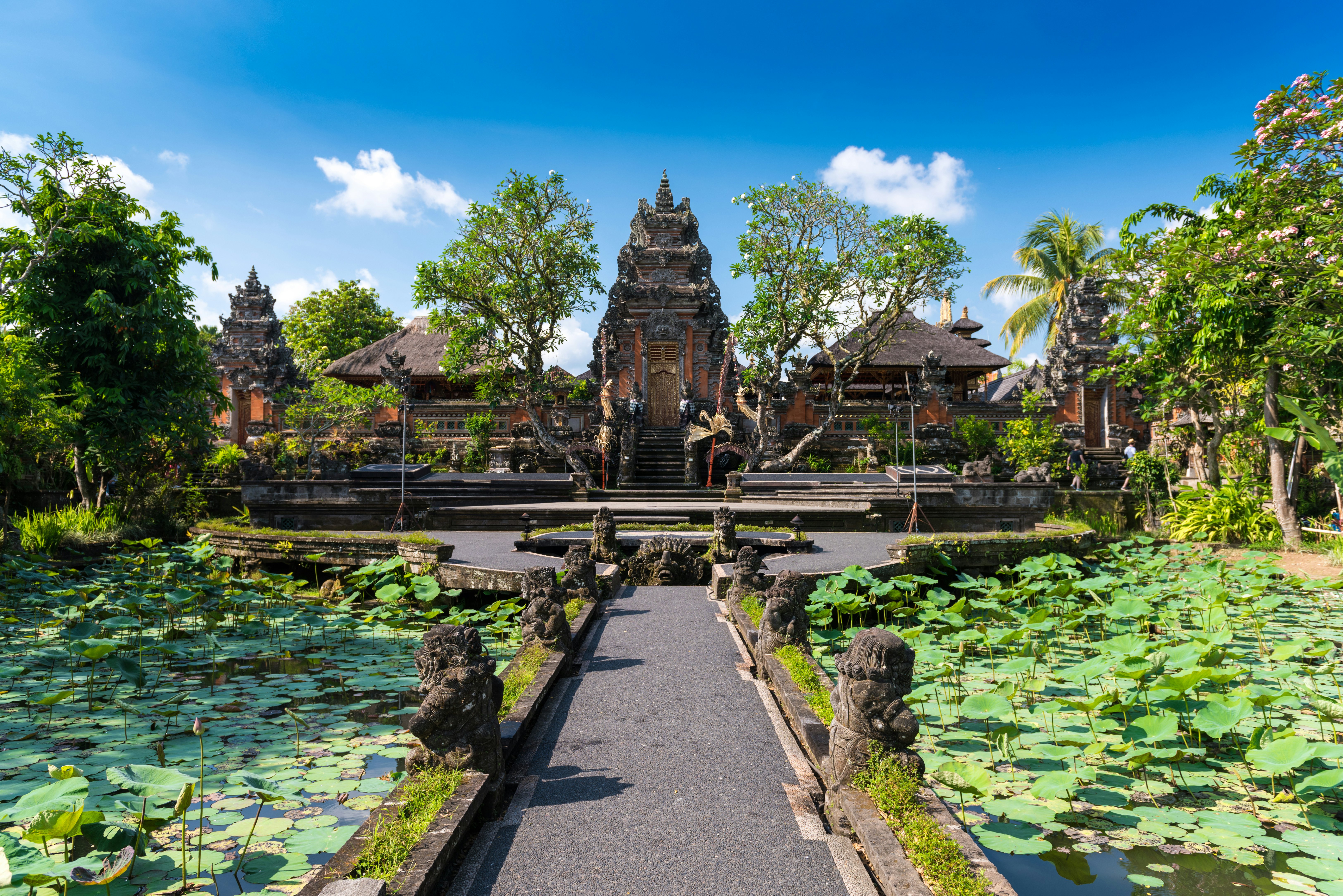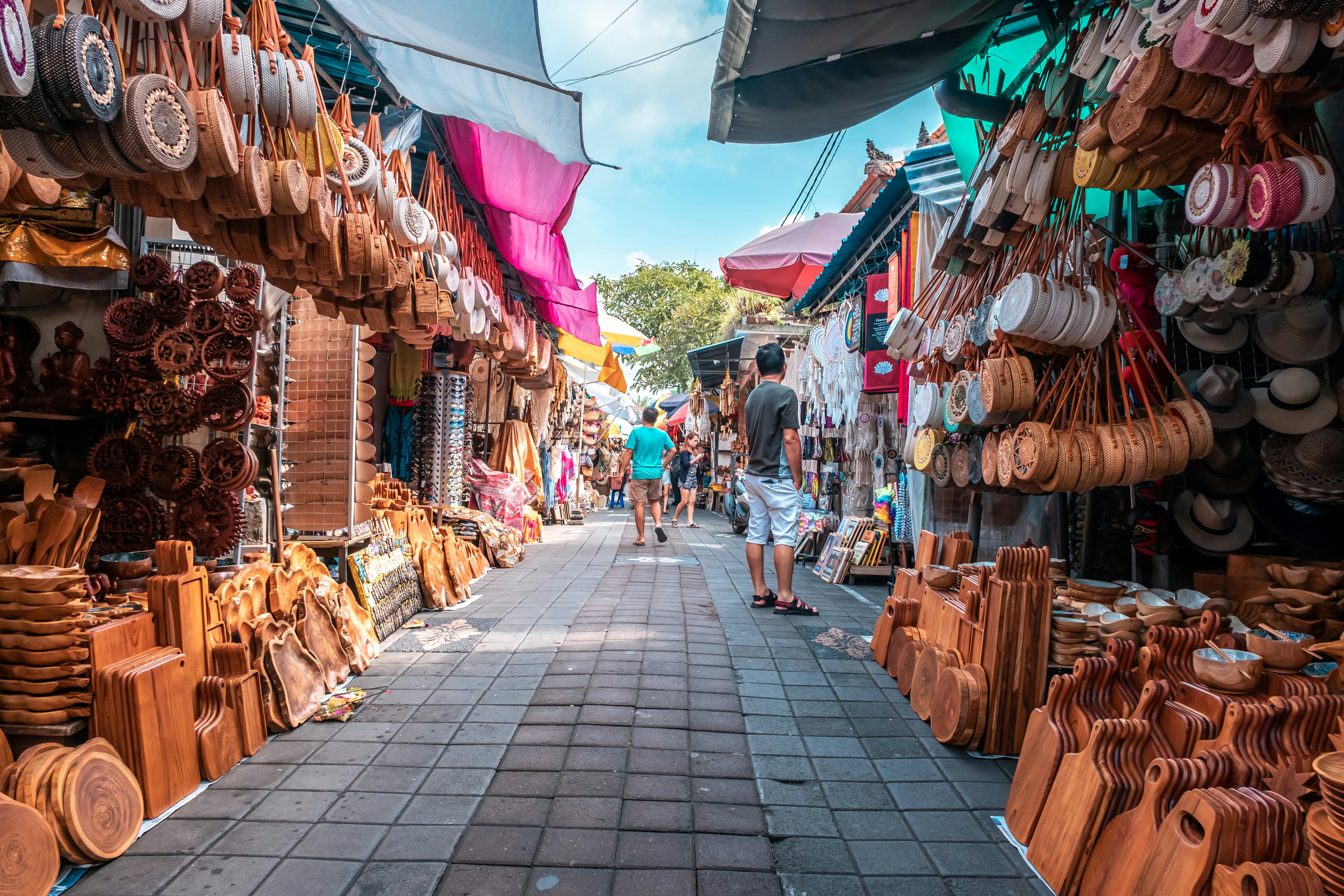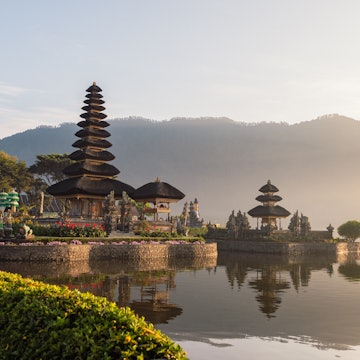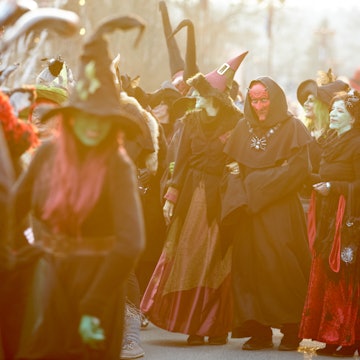

Ubud, Bali. Dynamoland/Shutterstock
One of Bali’s most seductive regions, Ubud has a cultured vibe, accented by thrills, surprises and unexpected delights. Centered on the town of the same name, the area is a vibrant hub for Balinese customs and crafts, famed for its temples, cultural institutions, artisan villages and wellness activities.
From nightly performances of Balinese dance and museums celebrating the work of the many artists whose creativity has flowered here to impossibly green rice fields that spill down lush hillsides to rushing rivers, Ubud is a feast for the soul.
Personal pleasures such as delectable dining, craft shopping, spa treatments and wellness classes only add to the appeal. As you plan your trip to Ubud, keep in mind our list of the 17 best things to do.

1. Experience Balinese dance performances in Ubud
Experiencing traditional Balinese dance is one of the top things to do on any visit to Ubud. Mesmerizing performances bring Hindu mythology to life through intricate movements, dramatic storytelling and the hypnotic sounds of the gamelan orchestra. Dance shows take place nightly at venues dotted around Ubud, each with its own atmosphere and style.
Choosing the right dance show will depend on what you’re looking for. For a classic and atmospheric experience, Ubud Palace is one of the most popular venues, with elaborate traditional performances in an ornate royal courtyard.
The Pura Dalem Agung temple makes the most of its sacred setting, with flame-lit backdrops enhancing the intensity of performances of traditional dance forms such as Kecak. If you’re looking for an elegant venue with stunning surroundings, the Pura Taman Saraswati temple hosts evening performances against a backdrop of tranquil lotus ponds.
The shows hosted at the Puri Agung Peliatan palace are ideal for those interested in seeing a more traditional, village-based performance featuring highly skilled dancers. For a deeper dive into the artistic heritage of Balinese dance, the Open Stage at the Agung Rai Museum of Art hosts performances from top troupes in an intimate museum setting.
Planning tip: Performances typically start at 7pm; arrive at least 20 minutes early to find a good seat, especially if you want to explore the venue beforehand. Tickets are usually available at the entrance to the venues, but booking in advance is recommended during the peak tourist season.
2. Visit the famous Ubud Monkey Forest sanctuary
Hidden behind a flashy theme-park-like entrance near the south end of Jl Monkey Forest, the famous Ubud Monkey Forest is a shady expanse that's home to three temples and more than 1000 well-fed and light-fingered monkeys. It’s a top destination for day-trippers from across Bali, but you can escape the crowds by visiting early or late in the day.
The park is alive with gray-haired and greedy long-tailed macaques, but don’t be fooled by their innocent-looking appearance – they can bite, so be careful. Watch your belongings carefully, and never feed the monkeys, lest you set off a frenzy.

3. Explore Ubud’s top temples with sacred carvings and lotus ponds
Ubud has dozens of historic temples, but many are closed to non-Hindu visitors. However, there are some noteworthy exceptions. Close to Ubud Palace, Pura Taman Saraswati Temple is a highly picturesque temple that’s always open to the public.
Water channels flowing from the rear of the temple feed a pond in front, which overflows with lotus blossoms. The temple’s ornate carvings honor Dewi Saraswati, the Hindu goddess of wisdom and the arts, who has clearly given her blessing to Ubud. Regular dance performances are staged at night.
Just west of the center, Pura Gunung Lebah sits on a jutting rock at the confluence of two tributaries of the Sungai Cerik river. Far below street level in a lush gorge, the setting is magical – listen to the rushing waters while you admire the impressive meru (multitiered main shrine) and a wealth of elaborate carvings.
A short drive north of Ubud, Tirta Empul is one of Bali’s most significant water temples, renowned for its sacred spring. It’s an important purification site for Balinese Hindus, and stone spouts line the bathing pools where pilgrims perform traditional cleansing rituals in the crystal-clear water.
Planning tip: When visiting Ubud’s temples, there are several things to know. Follow the lead of locals and wear modest attire, and remove shoes before entering the inner sanctuary. Note that women who are menstruating are not permitted inside. To avoid crowds, visit early in the morning or late in the afternoon.
4. Step into Balinese history at Puri Saren Agung
Sharing space with the still-in-use Ubud Palace in the heart of Ubud, Puri Saren Agung is relatively modest by the standards of Balinese architecture, but the sprawling temple complex features fine stone carvings, many created by noted Ubud artists such as I Gusti Nyoman Lempad. At night, the palace's main courtyard becomes a magical venue for Balinese dance performances, adding an extra layer of magic to this royal experience.
Planning tip: For a more immersive experience, consider booking one of the hidden mid-range guest rooms inside the palace through Airbnb.

5. Eat authentic Balinese food at Ubud’s best warungs
For an authentic taste of Bali, nothing beats eating at local warungs (food stalls). These small, family-run eateries serve up fresh, flavorful dishes showcasing the rich culinary traditions of Bali and Indonesia.
At In Da Compound Warung, tucked behind a guesthouse on Jl Goutama, you'll find bargain-priced dishes bursting with flavor. At Mama's Warung, friendly staff prepare spicy Indonesian classics, served with silky-smooth peanut sate sauce and fried sambal (chili paste).
If you're venturing toward Sayan, be sure to visit Nasi Ayam Kedewatan to sample their standout sate lilit – grilled skewers of minced chicken flavored with spices. Warung Pulau Kelapa, also along the route to Sayan, offers an expansive menu with some sensational sambals – ask for your meal "local style" if you like fiery flavors.
Planning tip: If you're not used to spicy food, ask for your dish to be made sedang (medium) or tidak pedas (not spicy). You can always add more heat in the form of sambal.
6. Walk along the Campuhan Ridge
The Campuhan Ridge Walk is a classic day trip from Ubud, following a scenic trail between two jungle rivers. Starting from the driveway of the Ibah hotel, a paved trail leads you across the Wos River, past the serene Pura Gunung Lebah temple, and uphill through rice fields to the village of Bangkiang Sidem. Along the way, you’ll pass local vendors, warungs and artists’ workshops, adding extra charm and a taste of the Ubud art scene to the stroll.
Planning tip: At the end of your walk, stop at Karsa Kafe in Bangkiang Sidem for a refreshing drink with a view before heading back.

7. Explore Bali’s famous rice terraces
Exploring the lush countryside around Ubud is one of the area’s top activities. The green hills, deep river valleys, and expansive rice fields offer a peaceful escape from the town’s bustling center. As you wander, you'll encounter unexpected delights, like artists working in trailside huts or hidden organic fruit juice stands poised beside the rice fields.
Take time to explore the Tegallalang Rice Terraces, a UNESCO-listed site preserving centuries-old terraced fields supplied with water using Bali’s traditional subak irrigation system. With emerald-green rice fields cascading down steep slopes, this area is a photographer's dream. Wander along the trails, or stop at a cafe overlooking the fields to enjoy the view with a fresh coconut in hand.
Planning tip: The best time to visit the Tegallalang Rice Terraces is around midday when local farmers are actively tending the fields – it’s a chance to see the subak irrigation system in action.
8. Enjoy Museum Puri Lukisan, Ubud’s prettiest museum
Set amid beautiful, tiered gardens, Museum Puri Lukisan is not only Ubud’s prettiest museum but one of its most important spaces if you're seeking cultural activities in Ubud. As the birthplace of the modern Balinese art movement, the museum has a special place in the history of Balinese creativity, and its four buildings showcase an extensive collection of Balinese art, spanning many different periods and styles.
The collection highlights both traditional and modern works, with a special focus on renowned Balinese masters such as I Gusti Nyoman Lempad, Ida Bagus Made and I Gusti Made Kwandji, offering a comprehensive overview of the island’s rich artistic heritage. Just beyond the museum, a river path leads to tranquil rice fields, adding to the peaceful ambiance.
Planning Tip: All works are labeled in English and have QR codes that link to additional info, so bring your phone. You can easily spend an hour or two here.

9. See Ubud’s finest paintings and other artistic masterpieces at ARMA
Stop by the Agung Rai Museum of Art (ARMA) to gain a deeper appreciation of Balinese artistic traditions, from classical Kamasan and Batuan styles to contemporary works. Among the highlights here are the paintings Portrait of a Javanese Nobleman and His Wife by Raden Saleh, and Green Rice Paddies by Nasjah Djamin.
The museum also has a collection of works by iconic Ubud artists such as the multitalented I Gusti Nyoman Lempad and Ida Bagus Made. Spread across several traditional-style buildings, the gallery offers a fascinating introduction to Balinese traditions, with intricate pieces such as Cremation Ceremony by I Ketut Sepi and Wali 'Ekadesa Rudra' by I Wayan Mardiana.
Planning tip: Plan to visit in the late afternoon, when you might catch a dance performance or a gamelan rehearsal. The museum’s Kafe Arma is the perfect place for a quiet coffee or snack before exploring the tranquil gardens that surround the museum.
10. Watch a shadow puppet show
Much more than just entertainment, wayang kulit (shadow puppetry) has provided a candlelit form of village entertainment for centuries, with puppeteers retelling colorful Hindu legends and morality tales with the same sacred seriousness as classical Greek drama.
Traditionally, performances lasted six hours or more, often continuing until sunrise, but today, you’ll find shortened performances at The Bali Culture Workshop and Kerta Art, as well as the Pondok Bambu Wayang Kulit near the Monkey Forest.

11. Pamper yourself with detox programs and massages at Ubud’s best spas
Holistic healing has long been a part of the Ubud experience. For a classic Ubud-style retreat, Ubud Sari Health Resort has been a go-to destination for decades. It’s surrounded by lush gardens where they grow the herbs used in their treatments, and the extensive treatment menu includes detox programs, massages and reflexology, which you can enjoy in a peaceful, natural setting.
Taksu Spa is another local favorite, known for its wide selection of massages and beauty treatments. There are private couples’ rooms and a healthy on-site cafe where you can unwind after a treatment. In Sanggingan, Bali Botanica Day Spa specializes in Ayurvedic therapies, making it a great choice for those looking for a more traditional healing experience.
If luxury is what you’re after, Mandapa Spa at the Ritz-Carlton delivers five-star indulgence in a breathtaking riverside location at one of Ubud’s top hotels, offering ultra-relaxing treatments with views of the Ayung River.
For something less showy, Ubud Wellness Spa in Pengosekan is a hit among Ubud’s creative community, offering straightforward but thorough treatments like the 4-hour Ubud Wellness Royal package, which includes an akar wangi flowers bath.
12. Connect with tradition through a balian's healing touch
The traditional healers known as balian play an important role in Balinese culture, treating illnesses, removing spells and channeling information from the ancestors. Attending a healing session is a fascinating experience, but you’ll need to make an appointment beforehand.
English is rarely spoken, so it’s important to understand what you’re getting into – your treatment will be public and may be uncomfortable or even mildly painful. Healing rituals can include being poked with sharp sticks and having chewed herbs spat onto your body.
For an excellent introduction to traditional Balinese therapies, contact I Madé Suryasa at Bali Healers; he organizes consultations with local healers and can help with translation.
Planning tip: If you're serious about the experience, do some research beforehand and approach it with an open mind and respect for Balinese spiritual traditions. As a starting point, the wellness retreat Floating Leaf has a useful blog entry on Bali's healing traditions.
13. Find wellness and inner balance at a yoga class
For the full Ubud yoga experience, the attractively designed Yoga Barn is the best place to start. More than just a studio, it’s a full-fledged wellness hub offering more than 100 classes weekly, spanning activities such as vinyasa, yin and hatha yoga, and ecstatic dance. Set amid lush gardens dotted with open-air pavilions, it also features an Ayurvedic spa, a health-focused cafe, and workshops on everything from meditation to sound healing.
For an intimate yoga experience, Radiantly Alive has a quieter, community-focused vibe, with highly skilled instructors and classes that blend traditional yoga techniques with modern movement practices.

14. Relax and enjoy Ubud’s cafe culture
Cafes in Ubud are more than just places to grab a cup of coffee – they’re essential to the town’s laid-back rhythm. For coffee aficionados, Seniman Coffee Studio is the go-to spot, offering everything from expertly brewed espresso to in-depth workshops on the art of the perfect latte. Another top spot for a central caffeine fix is Anomali Coffee, offering serious Indonesian brews and the best people-watching seats in town.
If you prefer your coffee with a view of nature, Sweet Orange Warung sits idyllically in the middle of Ubud rice fields, accessible via a scenic path near Museum Puri Lukisan. For a more upscale, air-conditioned space, Kafe Ubud has a health-conscious menu and a notice board that’s a great place to find out about alternative healing events.
15. Discover a hidden grotto adorned with mystical carvings
To uncover one of Ubud’s secret spaces, follow a quiet path through the rice fields of Sanggingan where towering banyan roots and moss-covered carvings create a mystical atmosphere. This grotto isn’t an ancient temple or a natural cave, but a pandemic-era project by local artisans who transformed its stone walls into a gallery of intricate carvings.
To find it, start at Jl Raya Sanggingan, passing Ubud Padi Villas. Follow the path south, then turn east onto a concrete trail where a towering banyan tree signals you’re in the right place. A narrow path leads downhill past a small temple, with the bamboo structures of Desa Alam Indah in the distance. Follow the sound of running water, and you’ll reach the grotto – an intimate hidden space for reflection.
Detour: After exploring the grotto, make your way to Yellow Flower Café in Penestanan for a well-earned break.

16. Browse Balinese artistry at the Ubud Art Market
The Ubud Art Market is a modern complex that brims with Balinese craftsmanship, located directly across from Ubud Palace on Jalan Raya, the main street that runs through the town center. Here, you'll find everything from delicate silk scarves and handwoven baskets to traditional wood carvings and rattan bags.
While some stalls cater to tourists with mass-produced items, the best crafts are made in nearby villages such as Tegallalang, making the market an excellent place to buy authentic souvenirs and support local artisans. Look for intricate silver jewelry, batik textiles and paintings that showcase Bali’s artistic traditions.
Mornings are the best time to visit, as the market is less crowded and vendors are more open to negotiation as the first sale of the day is said to bring good luck. Bargaining is expected, so don’t be shy about haggling, but keep it lighthearted and respectful.
Detour: If you’re after a more laid-back shopping experience, take a short walk northeast to Jl Kajeng. This street is lined with smaller vendors and independent boutiques selling everything from quirky prints and eco-friendly crafts to locally designed fashions.
17. Experience a guided tour of Ubud beyond the tourist trail
Perhaps the best 2 to 3 hours you’ll spend in Ubud is on a guided tour with Ubud Story Walks. Their detailed and entertaining tours cover Balinese culture and history in the region; you can learn about Ubud’s rich past and present, the unsung wonders of the temples in Pejeng, the works of the legendary artist I Gusti Nyoman Lempad, and much more.
If you prefer a more tranquil and reflective start to your day, Agung Rai’s Golden Hour Tour is a peaceful way to explore Ubud’s quieter corners. Led by the founder of the Agung Rai Museum of Art (ARMA), this early morning walk takes you through old villages and rice fields as the island begins to stir, offering an intimate glimpse of Balinese daily life.
If you want to see more of the region's natural beauty, Ubud native Dewa Rai’s Bali Nature Walks lead visitors along jungle trails and through the rice paddies, uncovering medicinal plants, local farming techniques and the hidden biodiversity of the region.
For wildlife enthusiasts, the birding tours offered by Bali Bird Walk are an unmissable experience. This operator was founded more than 30 years ago, and expert guides can help participants spot anything from 30 to 100 species on a single walk.
This article was adapted from the Indonesia guidebook published in July 2024.
















